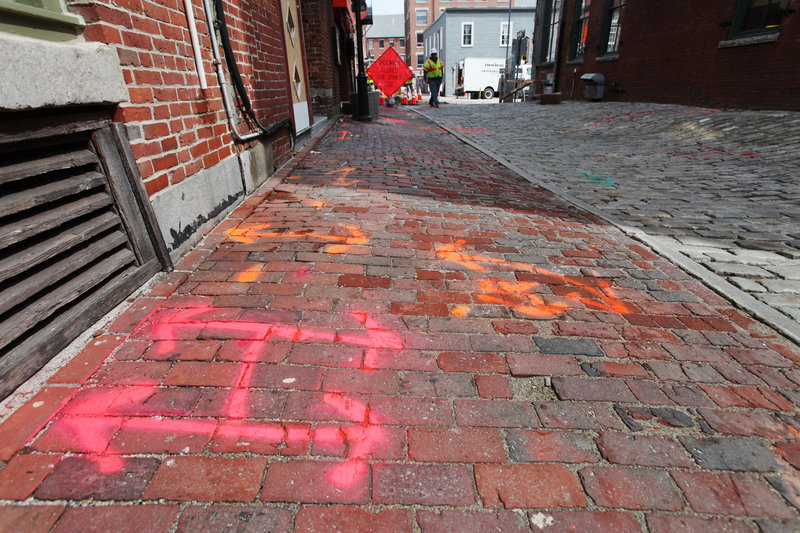PORTLAND – Throughout the Old Port and parts of downtown, there is paint all over the streets and sidewalks. Yellow and orange and green and blue. Arrows pointing in all different directions, sometimes accompanied by letters and numbers.
The markings look like indecipherable hieroglyphics to some, and sidewalk graffiti to others — if people notice them at all.
“I didn’t really pay much attention, but I guess it makes the city look a little dirtier,” said Gretchen Bates, 27, who was visiting Maine from Georgia and walking down Exchange Street on Sunday. “So, what does it all mean?”
To visitors, the paint means nothing, but to the utility crews that are tearing up small sections of asphalt throughout the busy part of the city, the symbols form an essential road map for their work.
“Everything is color-coded,” said Matt Doughty, project manager for Unitil, the natural gas company that is busy replacing century-old cast iron pipes underneath Portland’s streets with newer plastic lines. “Yellow means gas, green is sewer, red electricity, and blue is water. The arrows tell you what direction the lines are running and approximately how wide they are.”
The markings also are required under state law.
Before a contractor is cleared to dig in Maine, the company must contact DigSafe — a regional nonprofit clearinghouse that notifies participating utilities — at least 72 hours before machines move pavement. As part of the pre-work, contractors mark the streets and sidewalks to be certain of what they will encounter below ground.
In a rural stretch of road, there might be only one utility to worry about. In a congested, heavily populated area like the Old Port, there are several.
“It does look like a quilt at the moment,” said Jan Beitzer, executive director of the Portland Downtown District. “But it’s a state requirement. Nobody wants to see any line punctured.”
Doughty agreed that all the markings are done with safety in mind. Line breaks are not common, but if a working gas line were punctured, it could cause an explosion.
The paint is designed to be temporary. In most cases, it washes away within 30 days. If not, public services employees can use a pressure-washer.
“We painted everything in this area ahead of time, so there is a lot of paint on the street at the moment,” said Joe Renda, a project leader for Unitil who managed a crew on Dana Street, a small cobblestone connector between Fore and Commercial streets.
Unitil and its subcontractors plan to work regularly in the Old Port for much of April and May before they move out by Memorial Day, when the streets will begin to fill with tourists.
That means the paint will be around for a little while longer.
“I think it’s kind of neat, actually. It’s like a secret code,” said Jack Sprague, 56, who lives in town. “As long as it’s not permanent.”
Two years ago, some people complained about the amount of paint that started showing up in advance of ground work. Keith Gosselin, who worked on Fore Street, called it “an abomination.”
Beitzer said none of the downtown merchants has complained about the paint. Most are used to it by now.
“It’s just another sign of spring here,” she said.
Two workers at Mount Desert Island Ice Cream on Exchange Street said they haven’t really noticed the paint.
“We’re probably just used to it because we see it every day,” said one.
“I don’t think it makes the city look bad,” said the other. “It looks like they are trying to improve things.”
An employee at Old Port Tavern who was putting out a sign on the sidewalk Sunday afternoon before dinner said she doesn’t think the paint detracts much from the city.
“Most of the people who come in here probably don’t notice,” she said. “They certainly don’t notice when they leave.”
Staff Writer Eric Russell can be contacted at 791-6344 or at:
erussell@pressherald.com
Twitter: @PPHEricRussell
Send questions/comments to the editors.




